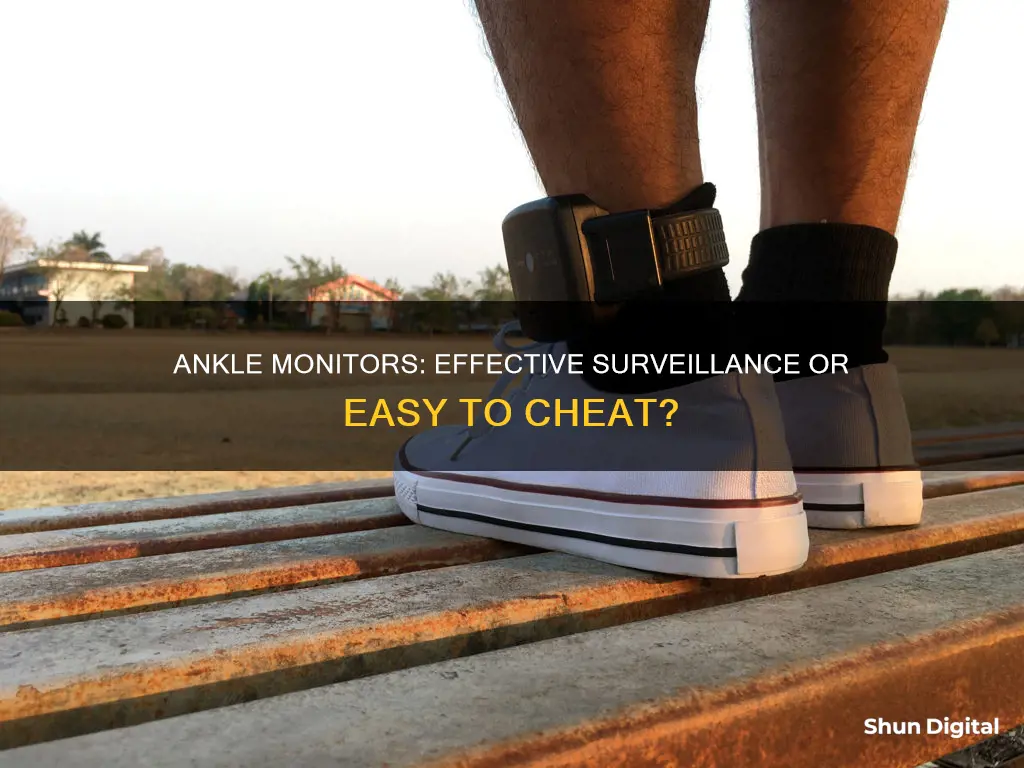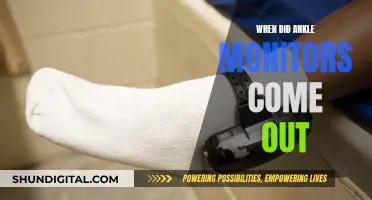
Ankle monitors, also known as electronic monitoring (EM) devices, have become increasingly prevalent in recent years, with a 140% increase in active monitors between 2005 and 2015. While they are touted for their accuracy in tracking individuals, there are various factors that can impact their effectiveness. These devices, often equipped with GPS technology, are used to monitor people awaiting trial, on probation or parole, or facing immigration proceedings. They are seen as a way to reduce prison populations and costs, but their accuracy is a crucial consideration.
So, how accurate are ankle monitors?
| Characteristics | Values |
|---|---|
| Accuracy | In optimal conditions, GPS ankle monitors can achieve accuracy levels of within a few meters. |
| Factors affecting accuracy | Satellite signal strength and visibility, urban canyons and signal reflection, multipath interference, environmental conditions, device quality and calibration |
| Benefits | Enhanced safety and security, operational efficiency, real-time insights, geofencing precision, evidence in disputes |
| Cost | The cost of ankle monitors ranges from $3 to $35 per day, with initial setup charges between $100 and $200. |
| Effectiveness | Scientific studies show that ankle monitors are cost-effective, help reduce prison populations, and reduce an individual's chances of returning to jail. |
What You'll Learn
- Ankle monitors can be highly accurate, but this depends on the quality of the device and the GPS signal strength
- They can detect attempts to obstruct the signal, such as by placing plastic between the monitor and ankle
- The use of ankle monitors has increased by 140% between 2005 and 2015
- They are often used to enforce curfews and limit how long someone can stay outside
- There are alternatives to ankle monitors, such as court reminders and transportation assistance

Ankle monitors can be highly accurate, but this depends on the quality of the device and the GPS signal strength
Ankle monitors can be highly accurate, but this depends on several factors, including the quality of the device and the GPS signal strength.
GPS ankle monitors are a sophisticated technology that has gained prominence in various sectors, including community corrections and business operations. The accuracy of these devices is influenced by the integration of GPS technology, which relies on satellite signals to determine an individual's location. In optimal conditions, such as clear sky visibility and minimal obstructions, GPS ankle monitors can achieve impressive accuracy levels, pinpointing a location within a few meters.
However, the accuracy of GPS ankle monitors can be impacted by various factors in real-world scenarios. One crucial factor is satellite signal strength and visibility. Tall buildings, dense foliage, and other obstructions can weaken the signals, leading to potential inaccuracies in location data. This is known as the "urban canyon" effect, where signals reflect off buildings, causing errors in determining the exact location.
The quality of the ankle monitor device itself also plays a significant role in accuracy. High-quality devices, equipped with advanced GPS technology, are more likely to provide precise results. Calibration and maintenance of the device are also essential factors.
Additionally, environmental conditions can affect accuracy. Adverse weather conditions, such as heavy rain, snow, or dense cloud cover, can obstruct GPS signals and impact tracking precision.
While ankle monitors can provide a high level of accuracy, it is important to acknowledge these variables that can influence their performance in practical settings. The effectiveness of ankle monitors relies on a combination of technological capabilities and an understanding of potential limitations.
Furthermore, the use of ankle monitors has sparked debates about their ethical implications. Some argue that they are a form of digital incarceration, leading to physical jails and prisons for minor technical violations, charging malfunctions, and false alarms. Additionally, the stigma, social isolation, and stress associated with wearing an ankle monitor can exacerbate mental health issues for the wearers.
Monitoring Memory Usage: A Guide for Node.js Developers
You may want to see also

They can detect attempts to obstruct the signal, such as by placing plastic between the monitor and ankle
Ankle monitors are often used as a tool for community corrections and to promote accountability and compliance. They are used in a variety of contexts, including within the criminal justice system, immigration cases, house confinement, and even wildlife conservation efforts. These monitors are equipped with GPS tracking systems or Radio Frequency (RF) technology to track the wearer's location. While they are generally effective, there are ways that individuals may attempt to obstruct the signal or hide their ankle monitor.
One method is to place a barrier, such as plastic, between the monitor and the ankle. This can block or interfere with the signal transmission, potentially disrupting the monitor's ability to accurately track the individual's location. However, it is important to note that modern ankle monitors are designed to detect such tampering attempts. They have advanced features that can identify and alert authorities to any unauthorized changes or obstructions to the signal.
The placement of plastic between the monitor and the ankle may trigger these tamper-resistant features. Ankle monitors are designed with sophisticated technology that can detect any attempts to obstruct or manipulate the signal. For example, if the plastic creates a barrier that weakens or blocks the signal, the monitor may interpret this as a potential tampering attempt and activate its alarm systems. This could result in immediate alerts being sent to the relevant monitoring authorities, who can then take appropriate action.
Additionally, the shape and thickness of the ankle monitor, as well as the gap between the device and the skin, can make it challenging to completely obstruct the signal without detection. The monitor's design includes corners that extend outwards, making it difficult to fully cover the device without attracting attention. Any attempts to cover the monitor with plastic or other materials may result in an unnatural appearance that could draw unwanted attention and lead to further investigation or action by authorities.
While it is possible to attempt to obstruct the signal of an ankle monitor, the advanced technology and tamper-resistant features of these devices make it challenging to do so without detection. The monitors are designed to identify and respond to any unauthorized changes or obstructions, ensuring that any attempts to manipulate the signal are quickly identified and addressed by the relevant authorities. Therefore, while placing plastic between the monitor and the ankle may be considered, the likelihood of successfully obstructing the signal without triggering an alert is low.
Monitoring App Resource Usage: A Comprehensive Guide
You may want to see also

The use of ankle monitors has increased by 140% between 2005 and 2015
The use of ankle monitors has surged in recent years, with a 140% increase in the number of people monitored using this technology between 2005 and 2015 in the United States. This rise can be attributed to the growing preference for alternatives to incarceration, particularly in the context of the COVID-19 pandemic and the need to reduce prison populations. During the pandemic, criminal justice systems sought to relocate people from crowded prisons to their homes, and ankle monitors became a tool to ensure compliance with quarantine orders.
The ankle monitor, often referred to as a "digital shackle," has been touted as a cost-effective solution that helps reduce prison populations and recidivism rates. However, the increase in their use has sparked concerns about their accuracy, ethical implications, and impact on the wearers' lives. The monitors carry a social stigma, associating the wearers with the criminal justice system and violent offenders. The bulky design of the devices makes them difficult to conceal, further adding to the stigma.
The accuracy of GPS ankle monitors is influenced by various factors, such as satellite signal strength, environmental conditions, and device quality. While they can provide precise location data in optimal conditions, obstructions like tall buildings or adverse weather can impact the accuracy of the monitoring. This technology is prone to technical glitches, including signal loss, short battery life, and inaccurate alerts, which can have severe consequences for the wearers.
The financial burden associated with ankle monitors is another critical issue. Wearers often have to cover the expenses themselves, paying daily fees that can amount to hundreds of dollars per month. This financial strain can lead to homelessness and further entangle individuals in the criminal justice system. Additionally, the monitors introduce new challenges and restrictions that can result in unexpected returns to prison, such as technical issues or delayed public transportation.
While ankle monitors have been presented as a solution to alleviate prison populations, their accuracy, ethical implications, and impact on individuals' lives demand careful consideration. The surge in their use during the pandemic has normalized their expanded use, and there is a risk that this trend will persist even after the health emergency subsides.
Connecting Toughbook to a Monitor: A Comprehensive Guide
You may want to see also

They are often used to enforce curfews and limit how long someone can stay outside
Ankle monitors are often used as an alternative to incarceration, allowing offenders to be punished without having to be placed in prison. They are used to enforce curfews and movement restrictions, and to ensure that individuals on parole or house arrest remain within a set boundary.
Radio Frequency (RF) monitors are typically used for this purpose. They notify the monitoring centre when the device comes into or departs from a designated area, rather than giving an exact location. This type of monitor is often used for curfew enforcement and house arrest, ensuring individuals remain within a specific area at specific times.
RF monitors usually have a maximum transmission distance of 50 to 150 feet. They require the wearer to be within 25 to 30 feet of the home unit to upload and send data. The home unit detects the bracelet within this range and sends signals to a monitoring centre. This allows for the enforcement of curfews and the monitoring of an individual's presence within a designated area.
The Global Positioning System (GPS) ankle monitors, on the other hand, provide more precise geographical coordinates. They can be programmed to notify the monitoring centre when the wearer enters or exits a specific range from their home. While GPS monitors offer more freedom of movement, case managers or officers can set exclusion and inclusion zones, ensuring individuals do not go to off-limit locations.
Both RF and GPS monitors can help enforce curfews and limit how long someone can stay outside. They provide accurate location data, allowing authorities to be alerted if an individual breaches their curfew or movement restrictions.
Easy Ways to Check Your Monitor's Refresh Rate
You may want to see also

There are alternatives to ankle monitors, such as court reminders and transportation assistance
Ankle monitors are a tool used in community corrections to promote accountability and compliance. They are often used as an alternative to traditional imprisonment, allowing individuals to serve their sentences while remaining in the community. These devices are worn around the ankle and track an individual’s movements and location using GPS technology. They are typically used for individuals on probation or parole, or those awaiting trial.
While ankle monitors provide a viable alternative to incarceration, they are not without their limitations and should be used with discretion. Some disadvantages include discomfort, skin irritation, and strict rules that, if violated, can result in additional penalties. Therefore, it's important to explore other alternatives to ankle monitors, such as court reminders and transportation assistance.
Court reminders can be implemented through automated messaging systems that notify individuals of upcoming court dates, helping them stay informed and reducing the chances of missed court appearances. This approach ensures that individuals are held accountable without the need for constant physical monitoring.
Transportation assistance can also play a crucial role in supporting individuals navigating the criminal justice system. By providing reliable transportation to and from court appearances, individuals can overcome barriers such as lack of access to transportation or financial constraints. This helps ensure their consistent presence at legal proceedings, promoting accountability and compliance.
Additionally, transportation assistance can extend beyond court appearances. Offering transportation to individuals struggling with mobility issues or those residing in remote areas can help them attend appointments, treatment programs, or community service obligations related to their supervision. This holistic approach ensures that individuals have the necessary support to fulfill their legal obligations and work towards successful reintegration into society.
By exploring alternatives like court reminders and transportation assistance, the criminal justice system can prioritize accountability while also addressing some of the limitations associated with ankle monitors. These alternatives demonstrate a commitment to supporting individuals through their legal journeys and empowering them to take the necessary steps towards rehabilitation and community involvement.
GeekSquad Monitor: Worth the Money?
You may want to see also
Frequently asked questions
Ankle monitors use GPS technology to track an individual's location. In optimal conditions, they can achieve accuracy within a few meters. However, various factors can impact the accuracy of ankle monitors, such as signal strength, environmental conditions, and device quality. Overall, they provide a commendable degree of accuracy for their intended purposes.
The accuracy of ankle monitors can be influenced by several factors. These include satellite signal strength and visibility, urban canyons and signal reflection, multipath interference, environmental conditions like weather, and the quality and calibration of the device itself.
Scientific studies suggest that ankle monitors can be effective in reducing recidivism. They support individuals transitioning from incarceration to the community and reduce the chances of returning to jail. Additionally, they provide cost benefits by reducing arrests and associated costs for local and federal agencies.
While ankle monitors can provide accountability and compliance for individuals, there are concerns about their potential for digital incarceration. Ankle monitors may lead to fees, social isolation, and restrictions on movement, impacting individuals' mental health and ability to reintegrate into society. Additionally, there are concerns about the stigmatization and financial burden associated with their use.







